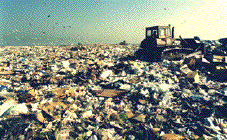
Waste-collection fees should reduce the need for landfills. (Photo: Kyodo)
SPENDING MONEY ON GARBAGE:
Charging for Collection Leads to Less Waste
FEBRUARY 26, 1997

Waste-collection fees should
reduce the need for landfills. (Photo: Kyodo)
The idea of charging shops and offices a fee to collect the garbage they produce is now being seriously considered by many municipalities that want to put the lid on the growing volume of waste.
The cost of waste disposal has reached some 2 trillion yen (16 billion dollars at a rate of 125 yen to the dollar) a year--twice the level of just eight years ago. Many landfills are nearing capacity, moreover, and municipal governments hope to encourage people to throw less away by charging for sanitation services.
The Tokyo metropolitan government became the first to charge a fee for the collection of general waste in December 1996 when it began asking businesses to pay for what their shops and offices throw out. The city of Yokohama followed suit the next month. Businesses located in these two municipalities have become more aware of the high cost of waste disposal and have been throwing away less.
Other local governments have shown interest in adopting similar measures, and the practice may soon spread around the country.
A 7.4% Reduction
The Tokyo metropolitan government had been collecting and disposing
of general (nonindustrial) waste, up to 10 kilograms per item or bag,
without charge. But in December it began charging 54 yen (43 cents) for
every 10 liters of the general waste it collects from businesses. On
average, each office or shop has been paying 4,617 yen (37 dollars) a month
to have their waste carried away. This added expense has forced shopowners
and office managers to think of ways to cut down on the volume of the trash
they produce.
Flower shops, for instance, have been chopping stems and leaves into small fragments and drying them so they will take up less space and weigh less. Some liquor shops have begun asking wholesalers to take back used bottles, cans, and cardboard boxes, and talks to forge a collection agreement between retailers and wholesalers are gaining momentum.
Some companies in the restaurant industry are planning to build a plant to turn kitchen waste into fertilizer. Under one such plan, the fertilizer will be used by local farmers, who will grow organic vegetables to be served by the restaurant.
A growing number of shops are hiring private companies to do the collecting. One Tokyo shopping center has 1,000 shops that have chosen to contract a private firm. The rates are cheaper than those charged by the local government, and there is greater flexibility in collection hours. The rise in demand for such services has prompted a number of companies to enter this market.
The Tokyo government expects to generate 19.0 billion yen (152 million dollars) in additional revenue through its paid collection service, but it has emphasized that the real motive is not padding the public coffers but getting people to throw away less.
The ploy seems to be working. The volume of waste generated in the 23 wards of Tokyo during the first month of implementation was 365,000 tons, a reduction of 7.4% from last year.
A Growing Fad
The volume of general waste generated nationwide has been either
holding steady or declining since 1990 due to measures designed to keep
waste volume down. Still, some 50 million tons were produced in fiscal 1993
(April 1993 to March 1994). Approximately 75% was incinerated, and the
remaining 25% was taken to landfills after being crushed or treated in
other ways. Even with these steps, most landfills around the country are
expected to become full within the next few decades.
The cost of waste disposal is also quite high. Sanitation workers, collection trucks, treatment plants, incinerators, and landfills all cost money. In fiscal 1993 these costs totalled 1.9 trillion yen (15.2 billion dollars). This is nearly twice the 1.0 trillion yen (8 billion dollars) spent in fiscal 1985.
Factors for the rising costs include the deterioration of incinerators due to the rise in plastic waste, which gives off intense heat when burned, and the introduction of expensive treatment methods that are friendlier to the environment than conventional approaches. These factors have pushed up the cost of building and maintaining waste-disposal facilities.
Many municipalities have therefore been trying to get people to throw away less and to recycle more. Yokohama, which followed Tokyo's lead in charging for the collection of general business waste, has also seen the volume of garbage produced by its shops and offices decline. "At present, only Tokyo and Yokohama charge for the collection of general waste," an official of the Ministry of Health and Welfare said, "but virtually all municipalities already require a fee for some services, like collection of bulky, oversized garbage. In the future, assessing a fee for the collection of general garbage should spread to other cities."
In many countries, a fee is charged for the general waste produced not only by businesses but also by private homes. In the city of Assen in the northern Netherlands, for instance, its 160,000 residents have been paying by weight for the waste they generate since 1994, and the city has been able to reduce waste volume by 16%.
The transition to a paid system in Tokyo was unexpectedly smooth, and it has helped halt the rise in the volume of waste generated. This may mean that households, too, may soon be asked to pay for the trash they discard.